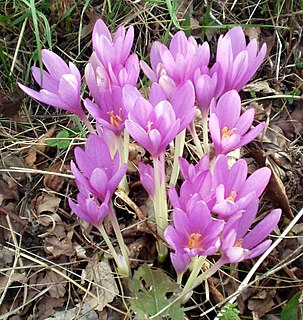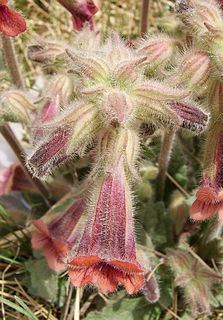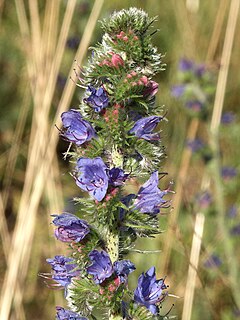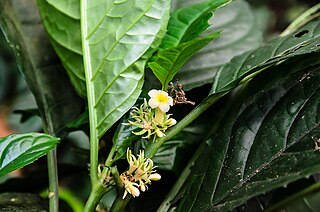
The Lamiales are an order in the asterid group of dicotyledonous flowering plants. It includes about 23,810 species, 1,059 genera, and is divided into about 24 families. Being one of the largest orders of flowering plants, Lamiales have representatives found all over the world. Well-known or economically important members of this order include lavender, lilac, olive, jasmine, the ash tree, teak, snapdragon, sesame, psyllium, garden sage, and a number of table herbs such as mint, basil, and rosemary. Lamiales and Orobanchaceae are both the largest populated parasitic angiosperms of flowering plants.

Gentianales is an order of flowering plants, included within the asterid clade of eudicots. It comprises more than 20,000 species in about 1,200 genera in 5 families. More than 80% of the species in this order belong to the family Rubiaceae.

Oleaceae, also known as the olive family, is a taxonomic family of flowering shrubs, trees, and a few lianas in the order Lamiales, It presently comprises 28 genera, one of which is recently extinct. The extant genera include Cartrema, which was resurrected in 2012. The number of species in the Oleaceae is variously estimated in a wide range around 700. The flowers are often numerous and highly odoriferous. The family has a subcosmopolitan distribution, ranging from the subarctic to the southernmost parts of Africa, Australia, and South America. Notable members include olive, ash, jasmine, and several popular ornamental plants including privet, forsythia, fringetrees, and lilac.

The Scrophulariaceae are a family of flowering plants, commonly known as the figwort family. The plants are annual and perennial herbs, as well as one genus of shrubs. Flowers have bilateral (zygomorphic) or rarely radial (actinomorphic) symmetry. The Scrophulariaceae have a cosmopolitan distribution, with the majority found in temperate areas, including tropical mountains. The family name is based on the name of the included genus Scrophularia L.

Agavoideae is a subfamily of monocot flowering plants in the family Asparagaceae, order Asparagales. It has previously been treated as a separate family, Agavaceae. The group includes many well-known desert and dry-zone types, such as the agaves and yuccas. About 640 species are placed in around 23 genera; they are widespread in the tropical, subtropical, and warm temperate regions of the world.

Hamamelidaceae, commonly referred to as the witch-hazel family, is a family of flowering plants in the order Saxifragales. The clade consists of shrubs and small trees positioned within the woody clade of the core Saxifragales. An earlier system, the Cronquist system, recognized Hamamelidaceae in the Hamamelidales order.

Gesneriaceae, the gesneriad family, is a family of flowering plants consisting of about 152 genera and ca. 3,540 species in the tropics and subtropics of the Old World and the New World, with a very small number extending to temperate areas. Many species have colorful and showy flowers and are cultivated as ornamental plants.

Colchicaceae is a family of flowering plants that includes 15 genera with a total of about 285 known species according to Christenhusz and Byng in 2016.

Plantaginaceae, the plantain family, is a family of flowering plants in the order Lamiales. In older classifications it used to be the only family of the order Plantaginales, but numerous phylogenetic studies, summarized by the Angiosperm Phylogeny Group, have demonstrated that this taxon should be included within Lamiales.

Asphodelaceae is a family of flowering plants in the order Asparagales. Such a family has been recognized by most taxonomists, but the circumscription has varied widely. In its current circumscription in the APG IV system, it includes about 40 genera and 900 known species. The type genus is Asphodelus.

Paulowniaceae are a family of flowering plants within the Lamiales. They are a monophyletic and monogeneric family of trees with currently 7 confirmed species. They were formerly placed within Scrophulariaceae sensu lato, or as a segregate of the Bignoniaceae.

The Loganiaceae are a family of flowering plants classified in order Gentianales. The family includes up to 13 genera, distributed around the world's tropics. There are not any great morphological characteristics to distinguish these taxa from others in the order Gentianales.

Gelsemiaceae is a family of flowering plants, belonging to the order Gentianales. The family contains only three genera: Gelsemium, Mostuea and Pteleocarpa. Gelsemium has three species, one native to Southeast Asia and southern China and two native to Central America, Mexico, and the southeastern United States. The eight species of Mostuea are native to tropical areas of South America, Africa, and Madagascar. The two genera were formerly classified in the family Loganiaceae. Pteleocarpa was originally placed in Boraginaceae or in its own family Pteleocarpaceae, but it is most closely related to Gelsemiaceae with which it shares significant characters.

Rehmannia is a genus of six species of flowering plants in the order Lamiales and family Orobanchaceae, endemic to China. It is the only member of the monotypic tribe Rehmannieae. Contrary to the immense majority of the taxa of Orobanchaceae, Rehmannia is not parasitic.

Calceolariaceae is a family of flowering plants in the order Lamiales that has been recently segregated from Scrophulariaceae. The family includes three genera, Calceolaria, Porodittia, and Jovellana, but analysis suggests that the monotypic Porodittia should be placed within Calceolaria. Recent molecular phylogenies that included Calceolaria have shown not only that this genus does not belong in Scrophulariaceae but also that it is the sister clade to the majority of the other families of the Lamiales. Morphological and chemical characters also support the separation of Calceolariaceae from Scrophulariaceae and other Lamiales. Some recent studies have supported a sister-group relationship between Calceolariaceae and Gesneriaceae. Given this close relationship, some authors opt to merge this family into Gesneriaceae as subfamily Calceolarioideae

Boraginales is a valid taxonomic name at the rank of order for a group of flowering plants. It includes Boraginaceae and closely related asterid families. The Boraginales include about 125 genera, 2,700 species and its herbs, shrubs, trees and lianas (vines) have a worldwide distribution.

Linderniaceae is a family of flowering plants in the order Lamiales, which consists of about 25 genera and 265 species occurring worldwide. Vandellia micrantha is eaten in Laos, but tastes bitter. Best known are the wishbone flowers Torenia fournieri and Torenia thouarsii, which are used as bedding plants especially in the tropics. Micranthemum is sold as an aquarium plant when it is called 'baby tears'.

The Carlemanniaceae are a tropical East Asian and Southeast Asian family of subshrub to herbaceous perennial flowering plants with 2 genera. Older systems of plant taxonomy place the two genera, Carlemannia, and Silvianthus within the Caprifoliaceae or the Rubiaceae. The Angiosperm Phylogeny Group classification of 2003 places the group in the Lamiales, as a plant family more closely related to the Oleaceae than to the Caprifoliaceae.

Peltanthera is a genus of flowering plants containing a single species, Peltanthera floribunda. The genus was originally placed in family Loganiaceae and has since been variously placed in Buddlejaceae, Scrophulariaceae, Gesneriaceae, or in its own family Peltantheraceae. As of 2016, it is considered by the Angiosperm Phylogeny Group to be unplaced in any family, but within the order Lamiales.

Lysionotus is a genus of flowering plants in the family Gesneriaceae. It occurs in the Himalayas, China, Japan, and Southeast Asia. The genus was described by David Don in 1822.



















